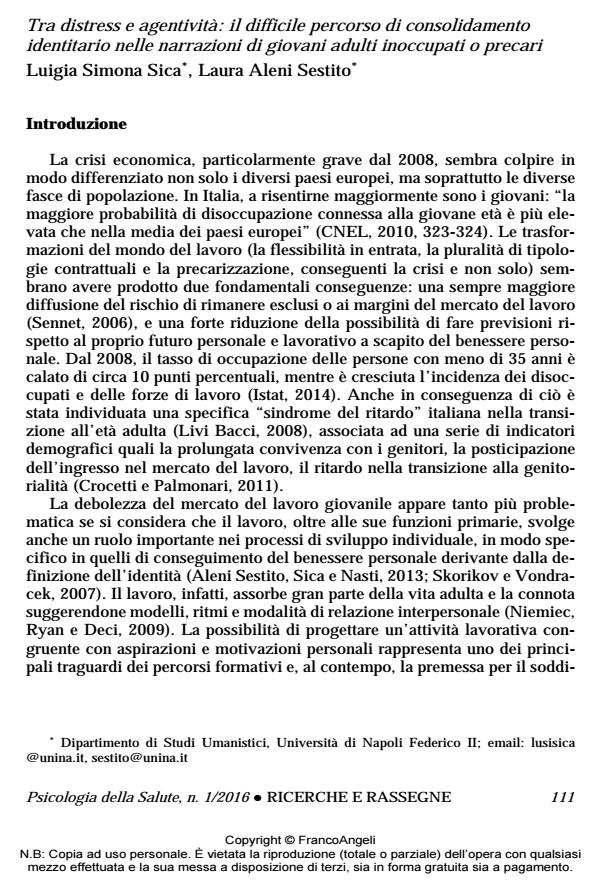Tra distress e agentività: il difficile percorso di consolidamento identitario nelle narrazioni di giovani adulti inoccupati o precari
Titolo Rivista PSICOLOGIA DELLA SALUTE
Autori/Curatori Simona Luigia Sica, Sestito Laura Aleni
Anno di pubblicazione 2016 Fascicolo 2016/1
Lingua Italiano Numero pagine 21 P. 111-131 Dimensione file 131 KB
DOI 10.3280/PDS2016-001010
Il DOI è il codice a barre della proprietà intellettuale: per saperne di più
clicca qui
Qui sotto puoi vedere in anteprima la prima pagina di questo articolo.
Se questo articolo ti interessa, lo puoi acquistare (e scaricare in formato pdf) seguendo le facili indicazioni per acquistare il download credit. Acquista Download Credits per scaricare questo Articolo in formato PDF

FrancoAngeli è membro della Publishers International Linking Association, Inc (PILA)associazione indipendente e non profit per facilitare (attraverso i servizi tecnologici implementati da CrossRef.org) l’accesso degli studiosi ai contenuti digitali nelle pubblicazioni professionali e scientifiche
La crisi socio-economica che ha investito l’Europa e le trasformazioni intervenute nel mondo del lavoro sembrano avere prodotto, oltre che effetti diretti sulla precarietà e sulla inoccupazione/disoccupazione giovanile, anche effetti indiretti sulla capacità dei giovani di progettare il proprio futuro e di pervenire ad una definizione coerente e stabile della propria identità personale e professionale. Il presente studio ha come oggetto i fattori di rischio e di protezione per il benessere e lo sviluppo correlati alle difficoltà di inserimento nel mondo del lavoro da parte dei giovani contemporanei. Mediante approccio narrativo all’identità, sono stati focalizzati i processi di ridefinizione identitaria di giovani adulti italiani che hanno incontrato specifiche difficoltà di inserimento nel mondo del lavoro. A tal fine, sono state analizzate le narrazioni di carriera prodotte da 80 giovani italiani inoccupati o precari, inerenti le loro deludenti esperienze di ricerca del lavoro. L’analisi lessicale delle produzioni narrative ha consentito di evidenziare cinque cluster lessicali, inerenti i temi della loro career identity e le strategie, adattive e/o disadattive, di fronteggiamento delle difficoltà incontrate. Tali cluster sono risultati differenziati in base alla variabile della provenienza geografica dei partecipanti. Sono discusse le implicazioni della definizione dell’identità in termini di agency e distress identitario.
Parole chiave:Precarietà/inoccupazione giovanile, identità, agentività, distress, analisi lessicale
- Sospesi nel tempo. Inattività e malessere percepito in giovani adulti NEET Anna Parola, Lucia Donsì, in PSICOLOGIA DELLA SALUTE 3/2018 pp.44
DOI: 10.3280/PDS2018-003003 - Identity Statuses and Event-Focused Narratives at University Starting Point in Italy Luigia Simona Sica, Koen Luyckx, Luc Goossens, Giancarlo Ragozini, Laura Aleni Sestito, in Journal of Adult Development /2017 pp.89
DOI: 10.1007/s10804-016-9249-2
Simona Luigia Sica, Sestito Laura Aleni, Tra distress e agentività: il difficile percorso di consolidamento identitario nelle narrazioni di giovani adulti inoccupati o precari in "PSICOLOGIA DELLA SALUTE" 1/2016, pp 111-131, DOI: 10.3280/PDS2016-001010